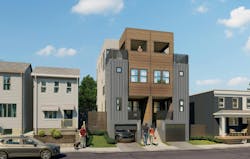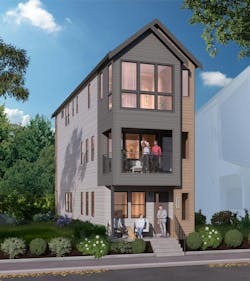Concept Homes to Promote the Wellness that People Want from Their Homes
During the early days of the pandemic, community design and marketing expert Teri Slavik-Tsuyuki of tsk ink found herself growing increasingly frustrated. She noticed that so much news coverage focused on the pandemic’s effects on many industries—but not its effects on the spaces where people were suddenly spending the bulk of their time. “No one was talking about the pandemic’s impact on how we felt about our homes,” Slavik-Tsuyuki says.
In 2020, Slavik-Tsuyuki—along with consumer strategist Belinda Sward of Strategic Solutions Alliance and architect Nancy Keenan, president of DAHLIN—launched the America at Home Study to uncover people’s behaviors, attitudes, and values around home and community as a result of living and working from home during the pandemic. The study accumulated almost 10,000 responses nationwide during early, peak, and post-pandemic periods.
The study’s third wave revealed “a huge concern,” Slavik-Tsuyuki says: a 17% decline in how physically well people felt in their homes, from October 2020 to October 2022.
The study also yielded two insights that Slavik-Tsuyuki had not come across before during her more than 20 years of conducting research. First, when asked what worried them, respondents ranked climate change third, behind the economy and jobs. “That said to us how we build homes needs to reflect that concern,” Slavik-Tsuyuki says. And second, healthier living and saving money tied for first place among respondents’ motivations for wanting wellness technologies in their homes. “That’s the first time I’ve seen wellness as a core purchase motivator,” she says.
America at Home Study Concept Homes
But Slavik-Tsuyuki and her colleagues didn’t want their research findings just to sit on a shelf. After building its first concept home in 2021, the America at Home Study recently announced the launch of two more concept homes that will address the study’s insights—in effect, turning the research into homes. Located in Pittsburgh, the America at Home Study concept homes will include a for-rent townhome with a ground-level accessory dwelling unit (ADU) and a for-sale paired townhome.
“We wanted to put the D in R&D in an industry that doesn’t typically do a lot of R&D,” Slavik-Tsuyuki says. “The concept homes bring the data to life. We hope to broaden the knowledge of the industry and help other builders, designers, and architects learn from these insights.”
Expected to open in October 2023, the rental home, called The Picket Fence, is a three-story, 2,0007-sf townhome plus a 660-sf ADU. The ground floor is a full studio home, and the main rental home above includes 3 bedrooms and 2.5 bathrooms. Expected to open in April 2024, the for-sale home, called The 412, comprises two 3-bedroom, 3.5-bathroom townhomes, 2,024 sf each.
The concept homes are the result of a collaborative effort between the founding partners of the America at Home Study and architect partner DAHLIN, builder partner EcoCraft Homes, manufacturing partner Structural Modular Innovations, and development partner Housing Innovation Alliance. The 412 also will serve as a Pro Builder Idea Home, with content published throughout its construction and completion.
Features of the Concept Homes
The America at Home study found that the top-ranked health and wellness feature in the home was private outdoor space—considered important by 67% of respondents. In response, both homes will provide multiple outdoor living spaces. The for-rent home will have a front porch for the ADU and a private second-floor deck for the unit above. The for-sale home will have an elevated front porch and a third-floor outdoor deck and covered patio.
To address respondents’ desire to spend time both with and apart from other occupants, the homes will include flex spaces that can serve as home offices or gyms.
In addition, the concept homes will promote health and wellbeing with plenty of natural light and high, open spaces. “From a design aesthetic, factory modular construction used to mean trailer homes. We break that mold,” says Ryan White, DAHLIN’s design director.
EcoCraft Homes will construct the homes in its offsite factory using volumetric modular construction, and then will assemble them onsite. Thanks to their highly efficient, factory-built construction, the homes will reduce the carbon footprint by 70% and construction waste by 90%, compared to equivalent site-built construction. The higher-performance homes will provide healthier indoor air quality via whole-house ventilation systems with high-capture filtration technologies. Each home also will meet the Department of Energy’s Zero Energy Ready Home Program.


